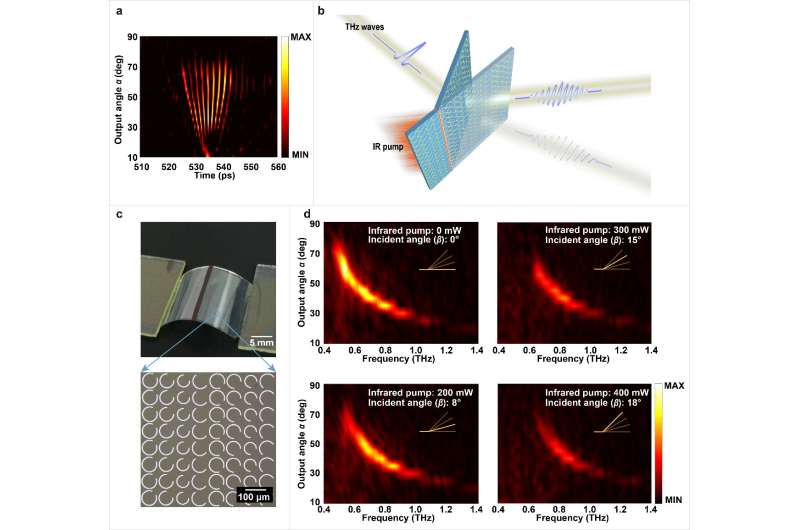This article has been reviewed according to Science X's editorial process and policies. Editors have highlighted the following attributes while ensuring the content's credibility:
fact-checked
peer-reviewed publication
trusted source
proofread
Active terahertz beam steering based on mechanical deformation of a liquid crystal elastomer metasurface

Traditionally, active metasurface research has primarily focused on changing the dielectric constant and permeability of the substrate, which frequently results in resonance effect and ohmic loss. However, a reconfigurable metasurface based on mechanical deformation can avoid these problems. At the moment, though, mechanical reconfigurable metasurfaces represented by the MEMS and FIB-induced deformation processes are difficult to fabricate or have limited resilience. As a new type of liquid crystal polymer material, Liquid Crystal Elastomer (LCE) can realize controllable and recoverable elastic deformation in response to temperature rise or light irradiation, which has generated enormous interest in the communities of chemistry, materials, and bionics. LCE's good optical/thermal-induced deformation performance suggests that it would be an excellent candidate to play an active part in reconfigurable metasurfaces, though until now it was rarely used to modulate metasurface response.
In a new paper published in Light Science & Application, a team of scientists, led by Professor Jianqiang Gu from the Center for Terahertz Waves, Tianjin University, China, and Professor Dan Luo from the Department of Electrical and Electronic Engineering, Southern University of Science and Technology, China, has synthesized a type of LCE composed of liquid crystal monomer (RM006), liquid crystal crosslinking agent (RM257), and photoinitiator (Irgacure 651). When the temperature exceeds the phase transition point, the strains generated in the LCE monolayer will bend the entire LCE to the side of molecular parallel orientation.
The research group explored the LCE film as a flexible substrate to design a phase-discontinuity metasurface with aluminum C-shaped split rings as resonators, realizing active manipulation of broadband terahertz wavefront steering. The linear phase gradient of the metasurface is built by eight C-shaped split rings with a phase interval of π/4, which are periodically arranged on the LCE substrate. When an incident terahertz wave passes through the metasurface, the output direction of the orthogonal polarization will deflect according to the generalized Snell's law, resulting in terahertz wavefront steering.
At beginning of this work, the specific scales of the C-shape split rings were determined using numerical simulations in harmony with theoretical prediction, and then the designed LCE samples were fabricated by photolithography, vacuum evaporation, and wet etching processes.
The output angle of the cross-polarized wave through the LCE metasurface sample was measured in an angle-resolved all-fiber terahertz time-domain spectroscopy system based on asynchronous sampling. It was proven that the LCE metasurface performs as an outstanding beam steerer whose output angle ranges from 70° to 25° for 0.48~1.1 THz.
To achieve the accurate deflecting of the flexible LCE substrate, the femtosecond pulse with central wavelength of 1030 nm was focused on the edge of the sample by a cylindrical lens, forming a focal line on the LCE substrate. The photothermal effect induced LCE bending around the irradiated line, while the non-irradiated part remained flat, thus realizing the overall deflecting of the metasurface. By changing the power of the pump infrared light, the researchers could control the deflecting angle of the LCE metasurface, and the modulation speed was able to reach the order of seconds.
With four pump powers, the LCE metasurface deflects to different degrees. Through raising the pump power, the output angle gradually increases, and this angle increment at low frequency is more pronounced. With the highest power infrared pump, the output angle of 0.68 THz terahertz wave reaches the maximum tuning angle of 22°.
"We further investigated the performance and prospect of the proposed LCE metasurfaces as terahertz beam steerer, frequency modulator, and active beam splitter," the researchers note.
"We believe that the potential demonstrated by our LCE metasurface provides considerable options for beam tracking, frequency filtering, and temperature sensing in the terahertz band, which in turn will advance R&D in next-generation wireless communication, terahertz imaging and terahertz spectroscopy inspection. The design principle proposed in this work can be extended to other frequency bands, opening a considerable path for the studies of active metasurfaces," the researchers forecast.
More information: Xiaolin Zhuang et al, Active terahertz beam steering based on mechanical deformation of liquid crystal elastomer metasurface, Light: Science & Applications (2023). DOI: 10.1038/s41377-022-01046-6
Journal information: Light: Science & Applications
Provided by Chinese Academy of Sciences





















